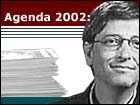
NEW YORK (CNN/Money) -
The keeper of Microsoft's cash is chief financial officer John Connors, an unassuming, bespectacled C.P.A. from Montana who works in a modest office on the fifth floor of Building 35 on the company's campus at Redmond. On a recent rain-drenched afternoon, he took a seat at the small circular table at one end of his office and walked through the mechanics of managing $40 billion. "It is," he acknowledges with a chuckle, "a big balance sheet."
Microsoft, Connors explains, has long pursued a low-risk investment strategy with its cash. In fact, he says, until the spring of 2000, the company invested almost exclusively in short-term U.S. Treasuries.
"But the balance started getting so big," he says, "that we were taking on quite a bit of interest-rate risk," so the company has broadened its holdings to include commercial paper, municipal bonds and mortgage-backed securities, among others.
This way, Connors says, "We are able to achieve returns slightly better than we would on cash, but because of diversification, we are doing it without a significant increase in risk or impairment of liquidity."
| |
 More on Microsoft
More on Microsoft
| |
| | |
| | |
|
He is being a little coy. There is some complex financial engineering at work here, and the returns can be considerably better than the company would get on T-bills alone. According to Risk magazine, a trade publication for financial managers, Microsoft has "quietly distinguished itself...using risk management and investment strategies worthy of the most sophisticated institutional investors."
The company has developed a proprietary computer model called, frighteningly enough, the Catastrophe Hedging Program (Version 2.5), which uses sophisticated derivatives and hedges to pick up as much return as possible while limiting exposure to changing interest rates.
The result? In one of the most treacherous interest-rate environments in years, Microsoft earned a remarkable 9.42 percent on its cash and short-term investments in its fiscal 2001, which ended June 30, 2001. "It was a good year," says a company spokesman. Microsoft says that its target return for cash and short-term investments is generally 4.5 to 5 percent.
But even at that lower rate, earnings on its cash stake have become an increasingly important part of Microsoft's business. In the final 3 months of calendar 2001, the company's short-term investments generated roughly $500 million in interest income and dividends, which came to 15 percent of the company's total quarterly pretax profits -- that's 1 of every 6 dollars.
To read about Microsoft's research and development expenses, click here.

|

